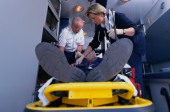
MONDAY, Nov. 28 (HealthDay News) — Most U.S. heart attack patients who have to be transferred to another hospital for a procedure to open narrowed or blocked coronary arteries aren’t sent in the recommended time of 30 minutes or less, new research shows.
The study included nearly 14,000 heart attack patients who required procedures such as balloon angioplasty or stent placement (called percutaneous coronary intervention, or PCI). The patients were treated at 1,034 hospitals between Jan. 1 and Dec. 31, 2009.
The researchers looked at the patients’ door-in to door-out (DIDO) time, the time between their arrival at and transfer from the first hospital to the second hospital where they underwent the procedures.
Only 9.7 percent (1,343 patients) had a DIDO time within 30 minutes, while 31 percent (4,267 patients) had a DIDO time of more than 90 minutes, according to study author Jeph Herrin, of Yale University School of Medicine in New Haven, Conn., and colleagues.
The investigators also found that the average DIDO time was 8.9 minutes longer for women than for men, 9.1 minutes longer for blacks than for whites, and 18.3 minutes longer for patients aged 18 to 35 than for those aged 46 to 55.
The study was published in the Nov. 28 issue of the Archives of Internal Medicine.
In a related research letter published online by the journal, University of California, San Francisco, researchers found that creation of a 24-hour cardiac catheterization laboratory shortened the length of time it took heart attack patients to undergo balloon angioplasty at a public hospital that previously had to transfer patients for the procedure.
Before the cardiac catheterization laboratory was created, the average door-to-catheterization and door-to-balloon times for patients who had to be transferred to another hospital were 184 minutes and 200 minutes, respectively. No patients had their coronary arteries reopened (revascularization) in less than 90 minutes.
After the 24-hour facility was created, average door-to-procedure times fell to 50 minutes for catheterization and 84 minutes for balloon angioplasty, respectively, and 65 percent of patients were revascularized in less than 90 minutes.
In an accompanying editorial published online, journal editor Dr. Rita F. Redberg noted that less than one-fourth of the nearly 5,000 acute care hospitals in the United States have PCI capability and even less can provide the treatment 24 hours a day, seven days a week.
“Despite years of hard work and noble efforts by many individuals and professional organizations . . . to enable hospitals to either provide primary PCI or reduce DIDO time in transferring to a facility that does, results have been disappointing,” Redberg wrote. “After years of well-intentioned arduous efforts to decrease DIDO time, it is time to consider other strategies.”
More information
The U.S. National Heart, Lung, and Blood Institute has more about coronary angioplasty.

